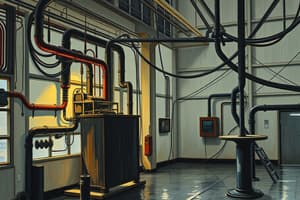Podcast
Questions and Answers
What is the percentage of framing in the given example?
What is the percentage of framing in the given example?
- 23% (correct)
- 30%
- 77%
- 50%
What is the R-Value of the given assembly?
What is the R-Value of the given assembly?
- R-23.5
- R-22.8 (correct)
- R-23.1
- R-22.5
What is the movement of air that results in heat transfer?
What is the movement of air that results in heat transfer?
- Radiation
- Convection (correct)
- Conduction
- Evaporation
What is the term for the movement of air within and through airspaces/cavities of building enclosures?
What is the term for the movement of air within and through airspaces/cavities of building enclosures?
What is the purpose of air films at the surface of enclosure assemblies?
What is the purpose of air films at the surface of enclosure assemblies?
What is the unit of measurement for R-Value?
What is the unit of measurement for R-Value?
What is the term for the movement of air as a result of pressure differences or natural buoyancy differences?
What is the term for the movement of air as a result of pressure differences or natural buoyancy differences?
What is the purpose of insulation in building enclosures?
What is the purpose of insulation in building enclosures?
What is the term for the transfer of heat through a material?
What is the term for the transfer of heat through a material?
What is the term for the resistance to heat flow through a material?
What is the term for the resistance to heat flow through a material?
Flashcards are hidden until you start studying
Study Notes
Thermal Comfort and Condensation Control
- More than 30% of all energy in Canada is used in buildings, with 30-60% of that energy used for space-heating in residential buildings.
- Reducing space-heating is a primary building enclosure consideration.
Heat Flow Basics and Calculations
- Heat flow rate is defined by Q, measured in Watts (W), which is equal to J/s or Btu/hr in Imperial units.
- Heat flux is defined by q, measured in W/m2, which is the density of the heat flow rate per unit area.
- q = Q/A, where A is the area.
- The fundamental equation for heat flow is Q = U · A · ΔT, also known as Fourier's Law.
Temperature Units
- Celsius (°C) is a metric unit for relative temperature, with 0°C being the freezing point of water and 100°C being the boiling point.
- Kelvin (°K) is a metric unit for absolute temperature, with 0°C being equivalent to 273°K.
- Fahrenheit (°F) is an imperial unit for relative temperature, with 32°F being equivalent to 0°C.
SI and Imperial Units – R-values
- R-value is the thermal resistance of a material or assembly, with industry using a mix of SI and Imperial units.
- R-value (imperial) is measured in units such as R-20, while RSI (metric R-value) is measured in units such as RSI-3.5.
- To convert from RSI to R-value, multiply RSI by 5.678.
SI and Imperial Units – U-values
- U-value is the thermal transmittance of a material or assembly, and is the inverse of R-value (U = 1/R).
- U-value (imperial) is measured in units such as U-0.30, while USI (metric U-value) is measured in units such as USI-1.70.
- To convert from USI to U-value, divide USI by 5.678.
Units – Lengths and Areas
- 1 inch is equal to 25.4mm, and 1 foot is equal to 304.8mm.
- 1 square foot is equal to 0.0929 square meters.
Solid and Porous Materials
- Solid materials transfer heat through conduction.
- Porous materials transfer heat through conduction, convection, and radiation.
Conduction
- Conduction is the transfer of energy at the molecular level through a solid material, and between materials in direct contact.
- The rate of heat flow through a material is dependent on its conductivity (k), measured in W/m·K.
- To minimize heat flow, building enclosure components should minimize the use of highly conductive materials.
Convection
- Convection is the movement of air due to pressure differences, natural buoyancy differences, or forced movement.
- Heat is transferred through convection, and moisture is also transferred through convection.
- Convection moves air within and through airspaces/cavities of building enclosures, and air films at the surface of enclosure assemblies provide thermal resistance.
Convection Through Assemblies
- Convection occurs within air cavity spaces and within fibrous insulation.
- Will cover convection through assemblies in more detail in the air leakage class.
Studying That Suits You
Use AI to generate personalized quizzes and flashcards to suit your learning preferences.




